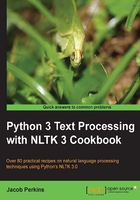
Conventions
In this book, you will find a number of styles of text that distinguish between different kinds of information. Here are some examples of these styles, and an explanation of their meaning.
Code words in text, database table names, folder names, filenames, file extensions, pathnames, dummy URLs, user input, and Twitter handles are shown as follows: "The sent_tokenize function uses an instance of PunktSentenceTokenizer from the nltk.tokenize.punkt module."
A block of code is set as follows:
>>> from nltk.tokenize import sent_tokenize >>> sent_tokenize(para) ['Hello World.', "It's good to see you.", 'Thanks for buying this book.']
When we wish to draw your attention to a particular part of a code block, the relevant lines or items are set in bold:
>>> doc.make_links_absolute('http://hello')
>>> abslinks = list(doc.iterlinks())
>>> (el, attr, link, pos) = abslinks[0]
>>> link
'http://hello/world'
Any command-line input or output is written as follows:
$ python train_chunker.py treebank_chunk
New terms and important words are shown in bold. Words that you see on the screen, in menus or dialog boxes for example, appear in the text like this: "Luckily, this will produce an exception with the message 'DictVectorizer' object has no attribute 'vocabulary_'".
Note
Warnings or important notes appear in a box like this.
Tip
Tips and tricks appear like this.